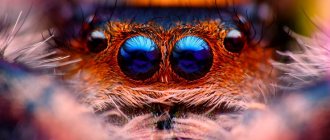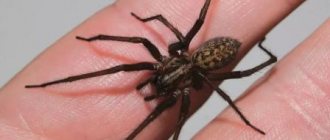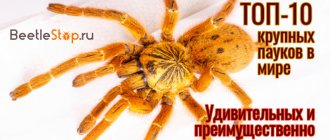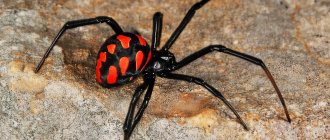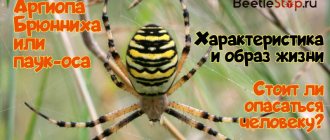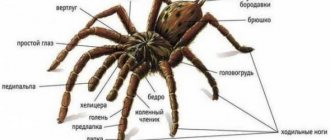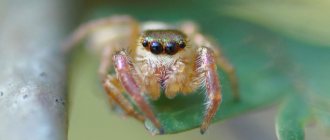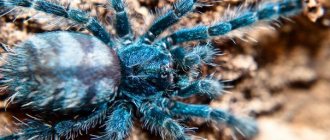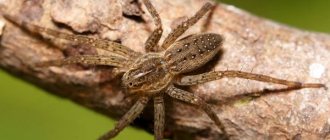- Wild animals
- >>
- Arachnids
The jumping spider is called a miracle of nature, a special type of arthropod. Among other representatives of this type of insect, it stands out for its ability to jump and has excellent eyesight. Many researchers claim that he even has intelligence. Jumping spider is a name that combines a whole group of insects. There are more than six hundred species. Representatives of this species are quite common in various parts of the world. Most of them prefer warm countries with a tropical climate.
Origin of the species and description
Photo: Jumping spider
Jumping spiders are representatives of arthropod arachnids; they are classified into the order Spiders, the family Jumping Spiders. Spiders of this species are representatives of flora and fauna that are found almost everywhere. One of the subspecies in 1975 was discovered even on the top of Everest, at an altitude of more than 6500 meters above sea level.
The history of spiders dates back more than 200 million years. The exact period of appearance of spiders is unknown due to the fact that finds with the remains of ancient spiders are extremely rare, since their body decomposes quite quickly. Scientists have discovered several important finds in amber. Some other body parts of ancient arachnids were found in frozen resin. They looked like small insects, whose body size did not exceed 0.5 centimeters.
Video: Spider jumper
The cephalothorax and abdomen had practically no separation. Ancient spiders had a tail section that was designed for weaving webs. Instead of webs, they produced a kind of dense, sticky thread. Spiders used them to wrap cocoons, line their lairs, or for other purposes. The ancient ancestors of modern spiders practically did not have glands that stimulate poisonous secretions.
There is a version that ancient spiders appeared on Gondwana. Then they very quickly spread almost throughout the entire earth. The subsequent ice ages reduced the habitat of spiders, and with them many species of ancient arthropods became extinct. Spiders tended to evolve quite quickly, change and divide into species.
Ultramarine tarantula (Poecilotheria metallica)
Like other tarantulas, Poecilotherium metalica is a fairly large spider, the body can reach a length of 7 cm, and the paw span is 21 cm.
The ultramarine tarantula is endemic to the Indian state of Andhra Pradesh, where its habitat is only 100 square kilometers. km and is highly fragmented as a result of human agricultural activities. The beautiful blue spider was first described in 1899, then unseen by scientists and was considered extinct until it was rediscovered in 2001.
In nature, ultramarine tarantulas live in groups on old trees, adults in the crowns, and young spiders at the foot or in burrows under the roots. They feed mainly on insects. They hunt at night. In cases of very close cohabitation, cannibalism is observed.
Pecilotheria metallica is a very rare and desirable spider among keepers, even despite its complex temperament and poisonous bite. It is considered the most toxic of all tarantulas, the venom causes pain and muscle spasms that can recur for two to three weeks.
Appearance and features
Photo: Black jumping spider
The jumping spider has fairly acute vision, which is required for successful hunting. The organs of vision are represented by eight eyes. They are located in three lines. The four largest eyes are located on the first line.
Interesting fact: The front organs of vision are able to rotate up and down, as well as in different directions. With the help of these moving eyes, spiders distinguish shapes, silhouettes, and colors.
The second row of visual organs is represented by two small eyes. The third row consists of two larger eyes located on either side of the head. This structure of the visual system allows you to assess the situation at all 360 degrees. In this way, you can easily avoid meeting the enemy. Vision helps for successful hunting. The peculiarities of the visual system also lie in the fact that spiders are able to see with each organ separately and put everything together into a single picture. The retina of the eyes also has an unusual structure, which allows you to reliably determine the distance to the desired object.
The respiratory system also has distinctive features. It even has peculiar lungs and a trachea. The body size of the horse does not exceed the size of a five-kopeck coin. The average body length is 5-7 millimeters. Sexual dimorphism is pronounced - females have a larger body than males. The cephalothorax and abdomen are separated by a thin groove. Different types of horses have a variety of appearance and colors depending on their habitat. Some species may resemble scorpions, ants, or beetles. The head section of the body is significantly higher, it is raised up above the abdomen.
Now you know whether the jumping spider is poisonous or not. Let's see where he lives.
Lifestyle
The jumping spider is able to live in a wide variety of conditions:
- he feels great in the forests, where any tree can become his permanent home
- in the mountains and on steep cliffs - in such places it hides in cracks;
- in the fields - there he has the opportunity to live in tall grass and in the branches of bushes;
- in addition, this spider completely fearlessly settles even in a person’s home, where you can always find a cozy sunny place.
The jumping spider prefers to be alone. He is most active during the daytime, and spends the night in some secluded place. Moreover, he arranges himself for the night in a special way - he weaves something like a cradle out of a web and sleeps in it until the morning.
Movement mechanism
These spiders are characterized by innate courage, and therefore they will flee only in extreme cases. When running away, a striped horse constantly turns around and assesses the distance to its pursuer, and since it has well-developed legs, it is often quite easy to hide from the enemy. At the same time, powerful limbs allow him not only to run quite quickly, but also to jump long distances - often a jump exceeds the size of the horse’s body by 30 times.
Despite the fact that this spider can cover a very impressive distance by jumping, it falls extremely rarely. The animal owes this not so much to insurance as to excellent vision - before jumping, the spider estimates the length of the distance and at the same time always accurately determines the point at which it will land.
During any movement, be it calm steps along the substrate or long, fast jumps, the jumping spider uses an internal hydraulic system. This method is very convenient - the limbs bend and unbend due to changes in the pressure of the fluid with which they are filled. This mechanism fully explains the amazing ability of this creature to cover enormous distances in one second.
Plus, the jumping spider can hold its body on absolutely smooth horizontal surfaces, such as glass. This ability is provided to him by small hairs and claws located on his limbs. By the way, other spiders do not know how to move on such surfaces.
Hunting and food
The jumping spider uses its silk thread for only two purposes: arranging the nest and protecting the masonry. But he doesn’t make a web for hunting - he simply catches up with the prey. The predator sits motionless and inspects the territory with the help of its many eyes.
Noticing the slightest movement, the spider slowly turns its head, fixes the gaze of the main pair of eyes on the source of the movement and determines the distance to it. Afterwards, he slowly approaches the victim, stops on the side or behind and makes a rapid jump. With the first pair of legs, the jumping spider captures prey, and with its jaws it bites into its chitinous cover and immediately injects a toxic substance and digestive juices.
The diet of the jumping spider includes:
- flies;
- small beetles;
- mosquitoes;
- ants.
Where does the jumping spider live?
Photo: Jumping spider in Russia
Spiders live almost everywhere. They can spread in vegetation, walls, in soil, on trees, bushes, in secluded corners of various buildings, etc. The habitat depends on the species. Jumping spiders can live in countries with a tropical climate; they feel good and comfortable in deserts, semi-deserts, or even in the mountains. They give preference to regions with warm climates and love sunlight.
Geographical regions where the horse pack lives:
- Queensland;
- New Guinea;
- North America;
- N.S.W;
- Africa;
- Australia.
The lifestyle of the jumping spider and its habitat vary greatly among representatives of the various subspecies of this species. Some of them tend to weave a web and spend most of their time on it, others manage to build silk nests, which they arrange in various secluded corners, while others can simply live quietly on the surface of the earth, or on any type of vegetation. Surprisingly, spiders are completely unpretentious in choosing their living conditions. They are easy to find even high in the mountains or on rocky terrain.
Seven new species of dancing spiders found in Australia (news). Video (00:01:38)
Seven new species of dancing spiders have been found in Australia. They say this spider can help get rid of arachnophobia, the fear of these insects. It is only eight millimeters long. This is an Australian jumping spider. And now he is performing a mating dance.
These bright insects live in bushes in the south of the continent.
: “They are simply amazing. Some people still think I’m making it all up because it’s just unbelievable.”
Recently, Sydney biologist Otto Jurgen and his colleague David Nowels discovered seven new species of jumping spiders. Before this, 41 species were known to science.
Otto has been photographing these insects for many years and posting photos and videos on the Internet.
: “People usually think that spiders are nasty, scary and dangerous. But through my photos and videos they learn that spiders can be cute, colorful and funny.”
To attract a female, males perform complex dances.
: “It’s the females who put pressure on the males to look better and dance better.”
Now biologists are busy searching for even more new species of dancing spiders.
What does a jumping spider eat?
Photo: Red jumping spider
A well-developed visual system allows spiders to obtain food for themselves. When a potential victim appears, the spider instantly turns in its direction. Horses not only evaluate their prey, but also determine as accurately as possible the distance that separates them. After this, the horse makes an instant jump if the victim is within its reach. The front pair of limbs is used to capture and secure the victim. With chelicerae, arthropods pierce the chitinous protective layer of insects and inject poison inside. It not only immobilizes and paralyzes the victim, but also partially digests the internal organs of the caught insect, turning them into a single continuous liquid substance. Horses drink this substance with pleasure, leaving only a chitinous shell.
What serves as the food source for the jumping spider:
- spiders inferior in size and dexterity;
- flies;
- bugs;
- mosquitoes;
- caterpillars.
Spiders can also catch their potential food using the trapping web they weave. They spread their web on tree branches, blades of grass, and branches of bushes. Spiders have a special structure of their limbs. They have small bristles and small nails that allow them to move on any surface, including flat, smooth glass.
Nutrition
Despite their body size, these arthropods are predators.
They do not weave spider webs to catch prey. They only need the web for comfortable movement. Small predators blend into their environment, waiting for their prey. They can remain absolutely motionless for a long time. They attack not only small insects - they also prey on those whose size is larger than the hunter.
During an ambush, cunning predators camouflage themselves, spread their forelimbs wide, preparing to attack instantly. If there is prey nearby, the arthropod approaches the victim and injects poison.
Toxic substances affect the victim’s nervous system, immobilizing it for a long time. This aggressive behavior is explained by the fact that the spider's front legs are equipped with claws, which contain a powerful poison that paralyzes prey.
When the victim is immobilized, the arthropod sucks all the vital juices out of it. Due to its weak jaw and small size, the sidewalker does not absorb its food entirely. Bumblebees, locusts, bees, and flies serve as food.
Features of character and lifestyle
Photo: Jumping spider
Jumping spiders are considered exclusively diurnal arthropods, since it is during daylight hours that they tend to be most active and hunt. They love sunlight and warmth. Often these spiders tend to bask in open sunny areas. These spiders are not at all afraid of people; they can settle in close proximity to them. Having seen a person, the horse does not rush to hide or look for cover. He watches him with interest. Often this particular type of arthropod is called orderlies. This is due to the fact that by appearing in new, previously uninhabited regions, spiders rid the area of harmful insects.
These spiders are helped to obtain food not only by their phenomenal vision, but also by another special function of the body - the hydraulic system. This is the body's ability to change the level of pressure in the limbs, due to which the size and length of the limb itself can vary. This allows arthropods to jump at different lengths. Spiders often make jumps of lengths that are 15-20 times the size of their body. However, for insurance, jumpers fix a strong thread where they want to jump.
Towards the end of the day, spiders look for a secluded place in which to weave their web. Such places can be in cracks in walls, under the bark of trees, under pebbles, etc. If the weather outside turns bad, there is no sun, it’s cold and it’s raining, spiders hide in their shelters for a long period of time. In the mornings in sunny weather they leave their shelters. After the spiders have thoroughly warmed up in the sun, they go in search of food.
Interesting fact: Scientists consider this type of spider to be brave insects, since they take flight only in extremely rare cases. When trying to escape from an enemy in this way, the horse quickly runs away, constantly turning in his direction. Spiders spend the cold season hiding in their shelters.
Interesting Facts
In the story about these creatures, many interesting facts about them have already been mentioned. And it’s not surprising, because their life is very unusual. But to all of the above, let’s add some more details.
- A well-developed special hydraulic system inside their bodies helps horses regulate blood pressure in their own legs, expanding and enlarging them for grandiose jumps. This complex biological mechanism becomes the main reason for their extraordinary jumping ability.
- The remarkable visual organs of such spiders, although they help them see the world in a color image, due to the structural features of the retina, they do not perceive green shades clearly enough, seeing them somewhat blurry. But this is not a drawback at all, because this property helps eight-legged creatures, ignoring green vegetation, to better focus on the object of the hunt, accurately determining the trajectory of their throw.
- Among the huge number of species of predatory horses, there was a vegetarian, by the way, the only herbivorous representative of the entire diverse spider tribe. This is a spider of the Bagheera Kipling variety. Such creatures live in Central America, live on acacia trees and eat belt bodies from them - growths on the leaves.
It has been noticed that horses watch people especially carefully with their many eyes. It is unlikely that this is associated with a desire to attack or with a feeling of danger. Rather, it is simply curiosity, in this way small creatures study a person, watch us.
People are also interested in them, and therefore representatives of some of the species often become pets. The royal jumping spider is especially suitable for this . Among its baby relatives, it is the largest and reaches sizes of up to 1.5 cm. Such unusual pets are kept in terrariums and often turn out to be very funny and cute.
Social structure and reproduction
Photo: Pair of jumping spiders
Males differ from females not only in size, but also in color, in particular, the color of the front pair of limbs on which the stripes are located. Each subspecies is characterized by individual characteristics of the mating season. However, all representatives of jumping spiders have one thing in common - the bewitching dance of the male individual. This dance allows you to attract the attention of the female you like. During this dance, the male raises his limbs and taps his chest with them in a certain rhythm. If several males compete for the attention of one female, the one who has longer pedipalps will take precedence. If a female has not reached puberty, males tend to wait for this moment.
Male individuals weave a kind of web to which they attach drops of seminal fluid. Then he lowers the pedipalps into the seminal fluid and only then transfers the seed into the female’s body. Before laying eggs, the female chooses a reliable shelter and lines it with cobwebs. This can be space under stones, tree bark, in wall cracks, etc. After a secluded place is found and prepared, the female individual lays eggs and carefully guards them until the offspring is born.
After birth, the young do not need a mother, as they immediately have hunting skills. The female leaves. After a few molts, the offspring that are born reaches sexual maturity. The average lifespan of a spider in natural conditions is about a year.
Chilean rose tarantula (Grammostola rosea)
There are two color variations of the species: pink and red Chilean tarantula
The Chilean pink tarantula is one of the most common house spiders. You cannot catch it in the wild; it is protected by UNESCO, but this is usually not necessary; the pink tarantula reproduces very well in captivity. He owes his popularity to his calm temperament, easy care, low price and attractive appearance. The life expectancy of the Chilean rose tarantula is 15-20 years.
The Chilean tarantula is medium-sized, the main color is brown, pink in places, the whole body is covered with light hairs. In nature, he digs deep holes and spends most of his life in them, but in the terrarium he even drags the substrate occasionally and leads a terrestrial lifestyle. It has difficulty moving on smooth glass surfaces due to poorly developed scopulae.
Natural enemies of jumping spiders
Photo: Jumping spider in nature
Spiders have quite a lot of enemies in their natural habitat. It is in order to save lives that many spiders disguise themselves externally as other insects - ants or beetles.
The danger to spiders comes from birds that eat these small arthropods. The spidercatcher bird shows particular interest in them. It is also worth noting that it is these spiders that lizards or frogs, as well as insects that are larger in size, are happy to hunt. Spiders tend to eat each other if there are no other objects nearby that can become prey. We are talking not only about the female, who after mating can eat the male. Often adult, sexually mature spiders attack young animals.
Very often, jumping spiders become victims of wasps. These are parasitic insects that lay eggs on the surface or inside the body of spiders. After some time, larvae hatch from the eggs and slowly eat the arthropod from the inside. If there are too many larvae, they provoke the death of the spider.
Importance in the ecosystem
Jumping spiders belong to the orderlies of garden plots. They benefit gardeners because they destroy pests, protect fruit trees, bushes with berries or beds from attacks by wood-eating beetles, elephant beetles, and also from large cabbage weeds.
Some gardeners specifically plant jumping spiders in their summer cottages. This eliminates the need for pesticides or other harmful chemicals.
This arthropod has high intellectual abilities, so some consider it as a pet. In captivity, the jumper lives up to 3 years.
It brings considerable benefits by destroying aphids on flowerpots. They do not move around the living space, but live in the flowerpot that the owner has chosen for them.
Nephila clavipes
The name clavipes was given to the species by Carl Linnaeus in 1767, it comes from the Latin. clava - “thick stick”; and pes - “foot”, “paw”
Next on the list is the Nephila Clavipes spider, with a bright pattern on its abdomen and colorful long legs. It is also known as the golden silk spider. Found in wooded areas of South and North America.
Females of the species Nephila clavips differ noticeably from males in size. The span of their legs reaches 12 cm with a body length of 4 cm. Males are 5 times smaller and 70 times lighter. By studying the DNA of nephiles, scientists found that females gradually increased in size during the process of evolution, while males remained the same as before in the Paleozoic.
The web of an adult female can reach 2 meters in diameter, not counting the anchor threads up to 3 meters long that secure the web between the trees. It is strong enough to hold a small snake, bird or bat. The yellow pigment in Nephila clavips silk gives the web a golden sheen, which is especially visible in the sun.
Nephiles often suffer from spiders of the genus Argyrodes, which steal food from them, and a dozen small parasites can even survive the orb weaver. He will have to leave his old networks and weave new ones.
